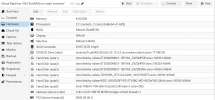To begin, I confirmed that my processor supports VT-x, VT-d is enabled in the BIOS and I turned IOMMU on in Proxmox
I installed Proxmox this week for the first time and created 5 VMs that all run relatively well. I am attempting to create either an Unraid or TrueNAS VM that requires hardware passthrough of a USB boot drive (for Unraid only) and a hard drive controller (or individual drives) from what I understand.
When I passthrough the USB boot drive and start the Unraid VM, the machine boots as expected.
My motherboard has an LSI 2308 onboard controller that I see listed among the PCI devices but when selected, the Unraid VM no longer sees the USB boot device but instead attempts to boot from a hard disk and loads an Avago Technologies MPT SAS2 BIOS, begins initializing and searches for devices at HBA 0 and of course loops continuously.
After spending an entire day trying to figure that out I decided to try a TrueNAS Scale VM instead. The OS installs, boots and I can access the GUI and log in remotely just fine but when I add the same controller, the VM doesn't even start and I see the following error in the Proxmox cluster log:
What am I doing wrong? What is the correct way to get all 8 drives added to either my Unraid or TrueNAS VM? I would prefer to use Unraid but at this point, I'll go with whichever one I can get working.
To be clear, none of this is mission-critical. I am new to Linux and just experimenting with the Proxmox software and the idea of virtualizing a NAS instead of running on bare metal.
Supermicro X10SL7-F motherboard
Intel Xeon E3-1245 v3 CPU
32 GB Crucial ECC RAM
8x2TB HDDs
I installed Proxmox this week for the first time and created 5 VMs that all run relatively well. I am attempting to create either an Unraid or TrueNAS VM that requires hardware passthrough of a USB boot drive (for Unraid only) and a hard drive controller (or individual drives) from what I understand.
When I passthrough the USB boot drive and start the Unraid VM, the machine boots as expected.
My motherboard has an LSI 2308 onboard controller that I see listed among the PCI devices but when selected, the Unraid VM no longer sees the USB boot device but instead attempts to boot from a hard disk and loads an Avago Technologies MPT SAS2 BIOS, begins initializing and searches for devices at HBA 0 and of course loops continuously.
After spending an entire day trying to figure that out I decided to try a TrueNAS Scale VM instead. The OS installs, boots and I can access the GUI and log in remotely just fine but when I add the same controller, the VM doesn't even start and I see the following error in the Proxmox cluster log:
Using the qm set command on the Proxmox shell I was able to individually passthrough only 5 of the 8 drives to the TrueNAS VM. When I attempt to add the 6th drive I receive the following error:kvm: -drive file=/dev/disk/by-id/ata-ST2000DM001-1ER164_Z4Z3NPQP,if=none,id=drive-sata1,format=raw,cache=none,aio=io_uring,detect-zeroes=on: Could not open '/dev/disk/by-id/ata-ST2000DM001-1ER164_Z4Z3NPQP': No such file or directory
TASK ERROR: start failed: QEMU exited with code 1
The 5 drives are visible in the TrueNAS GUI and are available for use in creating a ZFS poolunknown option: sata6 400 unable to parse option
What am I doing wrong? What is the correct way to get all 8 drives added to either my Unraid or TrueNAS VM? I would prefer to use Unraid but at this point, I'll go with whichever one I can get working.
To be clear, none of this is mission-critical. I am new to Linux and just experimenting with the Proxmox software and the idea of virtualizing a NAS instead of running on bare metal.
Supermicro X10SL7-F motherboard
Intel Xeon E3-1245 v3 CPU
32 GB Crucial ECC RAM
8x2TB HDDs




